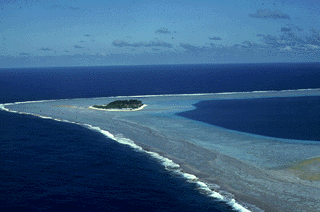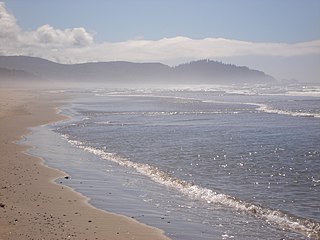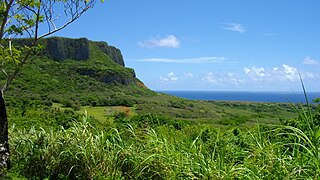
Howland Island is a coral island and strict nature reserve located just north of the equator in the central Pacific Ocean, about 1,700 nautical miles (3,100 km) southwest of Honolulu. The island lies almost halfway between Hawaii and Australia and is an unincorporated, unorganized territory of the United States. Together with Baker Island, it forms part of the Phoenix Islands. For statistical purposes, Howland is grouped as one of the United States Minor Outlying Islands. The island has an elongated cucumber-shape on a north–south axis, 1.40 by 0.55 miles, and covers 1 square mile.

Wild Horse Island, approximately 2,164 acres (876 ha) in size, is the largest island on Flathead Lake, the largest freshwater lake in Montana. Protected as a state park since 1977, the island near Big Arm Bay is home to abundant wildlife including bighorn sheep, mule deer, waterfowl, and bald eagles. It is managed by Montana Fish, Wildlife & Parks and lies within both the Flathead Indian Reservation and Lake County, Montana.

Tabernaemontana is a genus of flowering plants in the family Apocynaceae. It has a pan-tropical distribution, found in Asia, Africa, Australia, North America, South America, and a wide assortment of oceanic islands. These plants are evergreen shrubs and small trees growing to 1–15 m tall. The leaves are opposite, 3–25 cm long, with milky sap; hence it is one of the diverse plant genera commonly called "milkwood". The flowers are fragrant, white, 1–5 cm in diameter.

West Sister Island is an island of the U.S. state of Ohio located in the Western Basin of Lake Erie. The 82 acres (33 ha) island, jointly managed by the United States Coast Guard and the U.S. Fish and Wildlife Service, is Ohio's only designated Wilderness Area, the West Sister Island National Wildlife Refuge.

Rose Atoll, sometimes called Rose Island or Motu O Manu by people of the Manu'a Islands, is an oceanic atoll within the U.S. territory of American Samoa. An uninhabited wildlife refuge, it is the southernmost point belonging to the United States, about 170 miles to the east of Tutuila, the principal island of American Samoa. The land area is just 0.05 km2 at high tide. The total area of the atoll, including lagoon and reef flat amounts to 6.33 km2. Just west of the northernmost point is a channel into the lagoon, about 80 metres (260 ft) wide. There are two islets on the northeastern rim of the reef, larger Rose Island, 3.5 metres (11 ft) high, in the east and the non-vegetated Sand Island, 1.5 metres (5 ft) high, in the north.

The Okefenokee National Wildlife Refuge is a 402,000‑acre (1,627 km2) National Wildlife Refuge located in Charlton, Ware, and Clinch Counties of Georgia, and Baker County in Florida, United States. The refuge is administered from offices in Folkston, Georgia. The refuge was established in 1937 to protect a majority of the 438,000 acre (1,772 km2) Okefenokee Swamp. Though often translated as "land of trembling earth", the name "Okefenokee" is likely derived from Hitchiti oki fanôːki "bubbling water".
The Matlacha Pass National Wildlife Refuge is part of the United States National Wildlife Refuge System, located within the Matlacha Pass estuary, approximately 8 miles northwest of Fort Myers, Florida. The 538 acre (2.2 km2) refuge was established on September 26, 1908. The islands were established as a "preserve and breeding ground for native birds" by President Theodore Roosevelt. It is administered as part of the J. N. "Ding" Darling National Wildlife Refuge Complex.
The Ray Norbut State Fish and Wildlife Area is a 1,140-acre (460 ha) state park located near Griggsville in Pike County, Illinois. It borders on the Illinois River and is primarily made of steeply sloped bluffland that is part of the river's valley. Heavily wooded, this region is managed for whitetail deer hunting. The Ray Norbut complex also includes Big Blue Island, a 100-acre (40 ha) riparian island in the Illinois River. The park is managed by the Illinois Department of Natural Resources (IDNR).

The bridled white-eye is a species of white-eye native to the Mariana Islands and formerly Guam. The species' natural habitat is tropical forests, shrublands and urban areas.

Cape Meares National Wildlife Refuge is a National Wildlife Refuge of the Oregon Coast. It is one of six National Wildlife Refuges in the Oregon Coast National Wildlife Refuge Complex. Located on Cape Meares, the refuge was established in 1938 to protect a remnant of coastal old-growth forest and the surrounding habitat used by breeding seabirds. The area provides a home for a threatened bird species, the marbled murrelets. Peregrine falcons, once at the brink of extinction, have nested here since 1987. The refuge, with the exception of the Oregon Coast Trail, was designated a Research Natural Area in 1987.

Siletz Bay National Wildlife Refuge is a U.S. National Wildlife Refuge on Oregon's coast. It is one of six National Wildlife Refuges (NWRs) comprising the Oregon Coast National Wildlife Refuge Complex. The refuge consists of several discontinuous tracts north and south of the Siletz River where it enters Siletz Bay south of Lincoln City. Previously closed to public use, excluding viewing from outside the refuge boundaries and during special events, the refuge now has a boat launch offering access to non-motorized boats. Alder Island Nature Trail caters to visitors on foot, opened in 2017, and is 0.85 miles (1.37 km) round trip.

The Plum Tree Island National Wildlife Refuge is a National Wildlife Refuge in Poquoson, Virginia, located on the southwestern corner of the Chesapeake Bay. The 3,501-acre (14.17 km2) refuge is located at about the midpoint of the Atlantic Flyway, and is one of four refuges that comprise the Eastern Virginia Rivers National Wildlife Refuge Complex.

The Rappahannock River Valley National Wildlife Refuge is a National Wildlife Refuge in Warsaw, Virginia, United States that was established in 1996. It is managed by the United States Fish and Wildlife Service.
The Wallops Island National Wildlife Refuge is a National Wildlife Refuge located on Wallops Island, Virginia; the refuge was created on July 10, 1975, with the transfer of 373 acres (1.51 km2) of land from the National Aeronautics and Space Administration, and is administered by the United States Fish and Wildlife Service (FWS) along with Chincoteague National Wildlife Refuge (FWS). Much of the property is marshy, and there is also a sea-level fen on the island.

Cat Island National Wildlife Refuge was established on October 27, 2000, as the 526th refuge in the United States National Wildlife Refuge System. It is located near the town of St. Francisville, Louisiana, which is 30 miles (48 km) north of Baton Rouge. The refuge was established to conserve, restore, and manage native forested wetland habitats for migratory birds, aquatic resources, and endangered and threatened plants and animals. Additionally, it was created to encourage the use of volunteers and facilitate partnerships among the U.S. Fish and Wildlife Service, local communities, and conservation organizations to promote public awareness of resources of the refuge and the National Wildlife Refuge System.
Oʻahu Forest National Wildlife Refuge was established in 2000 to protect fish, wildlife, and plants which are listed as threatened or endangered species. The refuge encompasses approximately 4,525 acres (18.31 km2) and is managed by the U.S. Fish & Wildlife Service.
Green Bay National Wildlife Refuge is a National Wildlife Refuge of the United States located in the state of Wisconsin. It includes five all or part of six islands in Lake Michigan: Hog Island, Plum Island, Pilot Island, part of St. Martin Island and Rocky Island. Additionally it includes part of Detroit Island. The islands are near Washington Island off the tip of the Door Peninsula of Wisconsin and the Garden Peninsula of Michigan.

Tabernaemontana pandacaqui, known as windmill bush and banana bush, is a species of plant in the dogbane family Apocynaceae.

The Marianas tropical dry forests is a tropical and subtropical dry broadleaf forests ecoregion on the Marianas Islands in the western Pacific Ocean.













